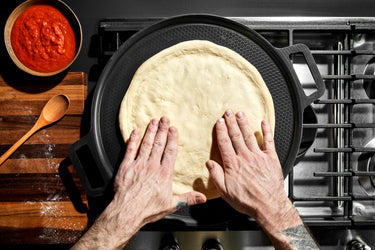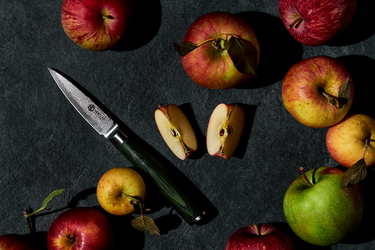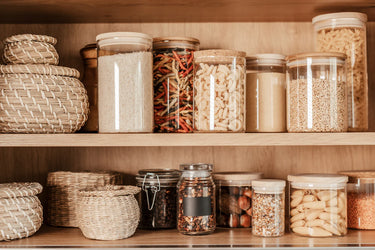Hand-Tossed vs. Pan-Made Pizza: Reviews and Examples

If there’s one dish that bridges the divide between all people, young and old, it’s pizza. As a kid, maybe you preferred a classic pizza with a crispy crust and a deliciously chewy golden brown bottom. As time went on, you likely branched out into other types of pizza.
From Chicago-style deep-dish pizza to Neopolitan to a Sicilian slice to New York-style pizza with a thin crust, there’s so much to explore.
Some pizza lovers might want to keep the recipe simple, sticking to mozzarella cheese, tomato sauce, and maybe oregano, while others see this classic food as an opportunity to try something new.
This is all to say that everyone has their own version of the best pizza. For too long, there has been a misconception that the perfect pie can only be bought at a pizzeria, but you can indeed make it easily at home.
The best part? You don’t even need expensive items like a pizza stone or pizza peel.
All you need to make a pizza that will have all of Italy jealous is a superb, oven-ready pan.
Is Hand-Tossed or Pan-Made Pizza More Beginner-Friendly?
If you walk into a pizza shop, you might expect to see people throwing dough into the air only to catch it with their fingertips.
They do this to stretch the dough out as much as possible so that it can get a crispier crust. (That, and it also looks awesome.)
As a result, the prospect of making hand-tossed pizza dough can seem intimidating for many home cooks.
Often, people find pan pizza crust to be easier than hand-tossed pizza crust. Undoubtedly, each method yields delicious results — but the techniques used to achieve the final product vary significantly.
In order to make a handmade pan pizza, you don’t need to stretch out the dough as much. This is a simpler process and leaves much less possibility for tearing the dough or spreading it too thin. For a thinner crust characteristic of hand-tossed pizza, you need to toe a fine line where the crust isn’t bulky but can still stand up to all your toppings and seasonings.
Another reason that pan pizza dough can be better for beginners is the number of tools you need to make it. You can use your hands to spread out the dough to get the right shape. From there, all you need is some olive oil and a good pan to achieve a deliciously buttery, thicker crust.
If you’re preparing a hand-tossed pizza, you will need to utilize a pizza stone and pizza peel — and you’ll also need to master the art of tossing the dough.
What Is the Difference Between Hand-Tossed and Pan-Made Pizza?
Now that we have established some of what you can expect in terms of how simple it is to make either a hand-tossed or pan-made pizza, let’s explore what the final products will look like.
It is worth noting that the main difference between these two preparations is the crust. Those who crave a thin-crust pizza might be better suited to a hand-tossed pie like a Neapolitan, while those who enjoy a breadier, fluffier crust will be delighted by something pan-made.
Each variety has its own merits; it just depends on your personal preference.
Since the crust serves as the base of your pizza, its thickness can inform what you should put on your pie. As a result, the cheeses and toppings can also be affected.
Cheese
The thinness of a hand-tossed pizza crust can often become overpowered by too many additions. The ratio of ingredients might not match up, causing the taste to suffer. The pizza itself might lose its structural integrity when faced with too much.
Luckily, this is much less of a concern with pan-made pizza.
Where you might have only managed a few slices of mozzarella with a thin crust, you can really push the envelope with a pan-made pizza. Get out of your comfort zone and add other cheeses like parmesan and provolone to make your pizza stand out.
Toppings
With a more bread-like thick crust, you have the option to add all sorts of accouterment to your pie.
For many, this manifests as thicker slices of veggies as well as meats such as pepperoni. This is where you can make your pizza how you want to make it. Don’t be afraid to take some risks!
Crust Thickness
As we’ve established, there are advantages to thinner and thicker pizza doughs. The only way to find out which one is right for you is by trial and error.
We know — to discover what you like, you’re (unfortunately) going to have to eat more pizza.
How Does Preparation Differ for Hand-Tossed and Pan-Made Pizza?
Let’s get into some more specifics about what you can expect from the process of making each type of pie.
Baking Temperature and Time
There are a few different ways to bake your pan-made pizza in the oven. First, you can cook it briefly on the stovetop, allowing air bubbles to pop up and the bottom to become golden. At that point, you would put on your sauce and toppings and transfer the pie into a hot oven until done.
Instead, we recommend pre-heating your oven to 500 degrees Fahrenheit and baking for seven minutes. Then, add your sauce, cheese, and toppings. Allow it to finish baking in the oven for another three to four minutes, keeping an eye on when the cheese is fully melted.
Hand-tossed pizza is made entirely in the oven and requires careful transference onto a scaldingly hot pizza stone.
Dough Preparation
Both types of dough are made of the same ingredients to form a gluten mixture, but the way they’re stretched (as well as how much) differs.
For a pan-made pizza, you simply stick your dough in the pan and stretch it to fit, taking care to get rid of any air under the pan. A hand-tossed pie must be stretched much thinner, and throwing is often required.
What Are Some Examples of Pan-Made Pizza?
If you’ve ever had a slice of pizza with a thicker, more robust crust, chances are that it was a pan-made pizza. Perhaps one of the most famous and easily accessible (but not the best) examples of this kind of pie is from Pizza Hut.
While you might not always get a complex flavor profile out of this brand, it could serve as a basis of knowledge for what pan-made pizza can be.
Now that you know what pan-made pizza can or should be, throw that out the window.
You can make your own pan-made pizza whateveryou want it to be. You can include any cheeses, toppings, and pizza sauces you like. You can make it all from scratch or choose to make it an easy weeknight meal with some store-bought ingredients.
One of the best parts of making a pizza yourself is the ability to fully customize it. Take advantage of that!
What Type of Pan Is Best for Pan-Made Pizza?
While hand-tossed pizza requires some items that many people won’t have lying around in their kitchen, pan-made pizza is different. To cook it, you just need a pan that works as well as the oven as it does on the stove.
For this and any similar jobs in the kitchen, we recommend the 10” HexClad Hybrid Pan.
Not only are HexClad pans perfect on the rangetop, but they’re aces in the oven, too. And when it’s all over, you can stick it right in the dishwasher. That’s right, the days of frustratedly working away at tough stains are over.
The Bottom Line
Many of us have spent our lives enjoying pizza, but we might not know how simple it can be to make at home. With the right pan in your arsenal, making pan pizza is easy as pie.
Sources:
How To Use a Pizza Stone in the Oven | Food Network
What Is Gluten and What Does It Do? | Johns Hopkins Medicine





